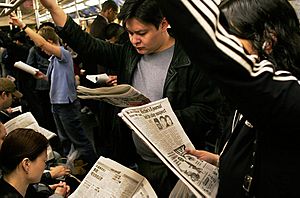Commuting facts for kids
Commuting is when people regularly travel between their home and their job or school. This travel usually takes them outside of their local neighborhood. Sometimes, it can also mean any regular trip between two places, even if it's not for work. People who commute daily are called local commuters, while those who travel longer distances, perhaps weekly, are long-distance commuters.
Contents
How Commuting Started
The word commuter first appeared in the 1840s in US cities like New York and Boston. Back then, railways allowed people to live in areas outside the city, called suburbs. These travelers paid a special, reduced fare to ride the train into the city. This reduced fare was called a 'commuted' fare. Later, the words "commute" and "commuter" came from this idea. These special tickets often let people make the same journey as many times as they wanted during a set period, and the longer the period, the cheaper it was per day.
Before the 1800s, most workers lived very close to their jobs, often less than an hour's walk away. Today, many people travel long distances to work, especially in countries with lots of factories and industries. This is because housing in city centers can be very expensive, public transportation might be limited, or there's a lot of traffic congestion.
People use many ways to commute, including cars, motorcycles, trains, buses, and bicycles. For example, Los Angeles is famous for its car traffic jams. In New York City, commuting is often linked to the subway. In cities like London and Tokyo, a "commuter" usually means someone who travels by train. In the future, more people might work from home, which could reduce the need for daily commutes. Some people believe that working from home could make employees happier and more productive.
Commuting and Suburbs
Commuting has greatly changed modern life. It has allowed cities to grow much larger than before. It also led to the growth of suburbs. Many big cities are now surrounded by "commuter belts" or "commuter towns." These are areas where people live and then travel daily to work or school in the main city.
As cities spread out, new businesses can pop up in areas outside the main city. This has created "reverse commuters." These are people who live in the main city but travel to the suburbs for work. There are also "secondary commuters" who live even further out and travel to these outlying cities or industrial areas for their jobs.
Traffic Jams
Most commuters travel at the same times each day. This causes morning and evening rush hours. During these times, roads and public transport systems get very crowded because they weren't built to handle so many people at once. For example, Interstate 405 in Southern California is one of the busiest freeways in the United States. Commuters there can spend up to two hours stuck in traffic during rush hour. Road construction or accidents can make these delays even longer.
Air Pollution from Commuting
Cars with only one person inside use more fuel and road space than cars shared by many people or public transport. This adds to traffic congestion. Commuting by car is a big reason for air pollution. Special lanes for carpooling can help people reach their destinations faster. Carpooling also encourages people to socialize and reduces air pollution.
Some governments and employers have started programs to encourage people to use other ways to travel. These include car-pooling or telecommuting (working from home). People are also using websites to find others to carpool with, which helps them save money.
The fumes from vehicles like trucks, buses, and cars cause air pollution. These airborne chemicals are a main cause of smog in many large cities. The main pollutants from vehicles are carbon monoxide, nitrogen oxides, and hydrocarbons. These chemicals react with sunlight, heat, and other things in the air to create the harmful gases and particles that make up smog.
Commuting in the United States
In the United States, the Census Bureau collects information about commuting times. This helps us understand how long people spend traveling to work based on their job, where they live, and how they travel. In 2014, the average commute time for adults in the US was about 26.8 minutes. People in construction and mining had the longest commutes (about 33.4 minutes). Those in the military had the shortest (21 minutes).
Generally, people who work in cities or suburbs in the US have similar commute times (around 30 minutes). However, people in rural areas have much shorter commutes (about 22.6 minutes). In the US, over 90% of workers travel by car, while about 5% use public transportation. Studies show that how long someone commutes is one of the most important things that affects how much free time they have.
Images for kids
See also
 In Spanish: Migración pendular para niños
In Spanish: Migración pendular para niños





